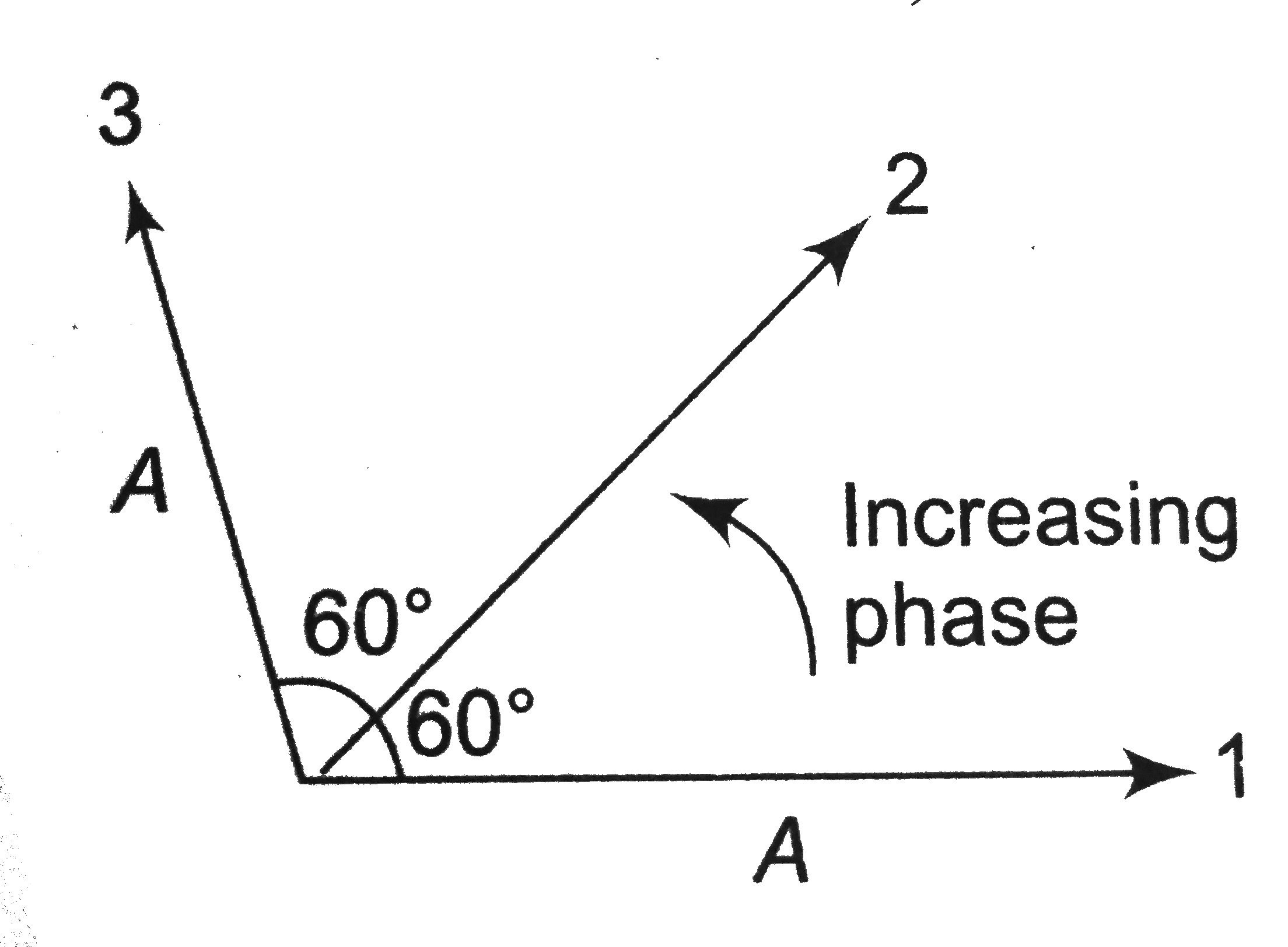Three simple harmonic motion of equal amplitudes A and equal time periods in the same direction combine. The phase of the second motion is 60∘ ahead of the first and the phase of the third motion is 60∘ ahead of the second. Find the amplitude of the resultant motion.
3A
2√2A
√3A
2A
The correct Answer is:D
The resultant of there vectors in the figure is 2A (along the direction of 2)

Related Playlists
- BOOK - A2ZCHAPTER - OSCILLATION AND SIMPLE HARMONIC MOTIONEXERCISE - Problems Based On Mixed Concepts24videos
OSCILLATION AND SIMPLE HARMONIC MOTION
- BOOK - A2ZCHAPTER - OSCILLATION AND SIMPLE HARMONIC MOTIONEXERCISE - Assertion Reasoning22videos
OSCILLATION AND SIMPLE HARMONIC MOTION
- BOOK - A2ZCHAPTER - OSCILLATION AND SIMPLE HARMONIC MOTIONEXERCISE - Simple Pendulum And Different Cases Of Shm25videos
OSCILLATION AND SIMPLE HARMONIC MOTION
- BOOK - A2ZCHAPTER - NEWTONS LAWS OF MOTIONEXERCISE - Chapter Test30videos
NEWTONS LAWS OF MOTION
- BOOK - A2ZCHAPTER - PROPERTIES OF MATTEREXERCISE - Chapter Test29videos
PROPERTIES OF MATTER
Similar Practice Problems
- Question 1 - Select One
Time S.H.M. of equal amplitude a and equal time period in the same direction combine. The first is 60∘ ahead of the second and second is 60∘ ahead of the third S.H.M. The amplitude of the resultant oscillation is:
AaB2aC0D4a - Question 1 - Select One
The equation of a simple harmonic motion (amplitude 5 cm and time period 0.5 second) is
Ay = 0.5 sin 2πt,By=0.5sin(2at)5Cy=5sin4πtDy=5sinπt - Question 1 - Select One
Three SHO's of equal amplitude A and equal time period combine in the same direction. The difference in phase between successive SHO's os 60∘ahead of the other. The amplitude of the resultant oscillation is
AAB2AC0D4A - Question 1 - Select One
A simple harmonic motion of amplitude A has a time period T. The acceleration of the oscillator when its displacement is half the amplitude is
A4π2AT2B2π2AT2C−4π2AT2D−2π2AT2 - Question 1 - Select One
For a particle executing simple harmonic motion, the amplitude is A and time period is T. The maximum speed will be
A4ATB2ATC2π√ATD2πAT - Question 1 - Select One or More
Three simple harmonic motions in the same direction having the same amplitude and same period are superposed. If each differ in phase from the next by 45∘, then
Athe resultant amplitude is (1+√2)aBthe phase of the resultant motion relative to the first is tan−1(12)Cthe energy associated with the resulting motion is (3+2√2) times the energy associated with any single motion.Dthe resulting motion is not simple harmonic
Similar Questions
(a) A particle is subjected to two SHMs of same time period in the same direction. If A1=6cm, A2=8cm, find the resultant amplitude if the phase difference between the motions is (a) 0∘, (b) 60∘, (c) 90∘ and (d) 120∘.
(b) In the previous problem if A1=A2=a and resultant amplitude is also a, find phase difference between them.
(c) Three SHMs of equal amplitude A and equal time periods in the same direction combine. The phase of the second motion is 120∘ ahead of first and the phase of the third motion is 120∘ ahead of the second. Find the amplitude of the resultant motion.View SolutionA particle is subjected to three SHM's in same direction simultaneously each having amplitude a and equal time period. The phase of the second motion is 300 ahead of the first and the phase of the third motion is 300 ahead of the second. Find the amplitude of the resultant motion.
View SolutionA simple harmonic motion has an amplitude A and time period T. What is the time taken to travel from x=A to x=A/2?
View SolutionA particle is subjected to two simple harmonic motions of sae time period in the same direction. The amplitude of the first motion is 3.0 cm and that of the second is 4.0 cm. Find the resultant amplitude if the phase difference between the motion is a. 0∘,b.60∘,c.90∘
View Solution

